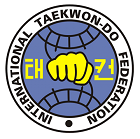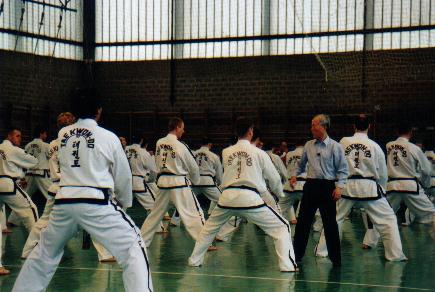Umpiring Patterns

National Umpire Course Notes
Umpiring Patterns
These are some recommended guidelines for Umpiring Patterns competitions, for domestic and local events based on the ITF Tournament Rules.
Note : The ‘Official’ ITF Rules are only applicable to ITF World Championships, and as such much of it is not relevant to in-house, local, state and national level competitions.
A National Organization, or any competition for that matter, should adopt rules that are specific to:
- the event/s being conducted.
- the ages of participants
- the experience levels of participants
- the objective of the competition
- the facilities being used
- the schedule / time available
- the umpires/officials available
Purpose of the ITF Umpiring Rules
- Clarify responsibilities of officials
- Outline scoring criteria for each event
- Determine eligibility of competitors
- Outline operational procedures of all events
- Assist competitors and coaches in event preparation
- Ensure the safety of all competitors and officials
Characteristics of a good Umpire:
- Be consistent and fair in all judgements
- Base all decisions on the Rules of the competition
- Be assertive and confident in all decisions
- Display Punctuality and work ethic
- Be professional in appearance and behaviour
- Be willing to receive constructive feedback and advice from Tournament Directors
- Have a thorough knowledge of the rules – updated regularly
- Integrity, honesty and strength of character
- Ability to follow instructions
- To be flexible and adaptable in various official roles
- Some appreciation and empathy of the competitor’s task
- Ability to make logical, correct decisions quickly and under pressure
- Do not engage spectators or competitors while judging.
- have a basic knowledge of First Aid
- You must be conversant with all patterns / techniques you are to judge
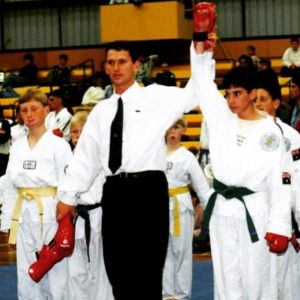
ITF Umpiring uniform consists of
- a navy blue blazer jacket,
- white, long sleeved shirt,
- navy blue trousers or knee-high skirt
- navy blue tie (with no other colours or decorations- I.T.F. logo permitted)
- white socks
- white gym/Taekwon-do shoes
Alternatively, polo tops may be used where a sponsorship arrangement is in place, or approved by the National Organization.
The Competition area – Patterns
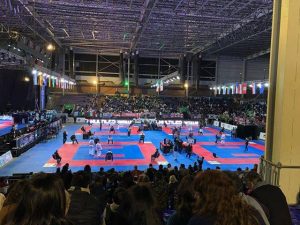
Patterns Ring size should be 9m by 9m square of competition space.
- Patterns judges are positioned across the front of the ring.
- The official Jury table is positioned behind judges
- There should be adequate distance between the competition area and spectators for safety and integrity of judging
- Judges should be positioned a safe distance from competition area
BOUT PROCEDURE
The pyramid system of elimination is generally used for both team and individual at Black Belt Levels
Other formats are at the Tournament Organizers discretion, but must be made clear prior to event registration.
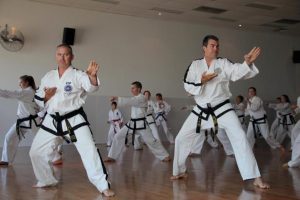
Individual
- Competitors will compete 1 to 1 and will perform simultaneously one (1) optional Pattern and one (1) designated Pattern (appropriate to their degree), selected at random by the Jury President.
- The boxes containing the names of the optional patterns will be taken out of the basket by the Jury President before choosing the designated pattern. The winning competitor will progress to the next round.
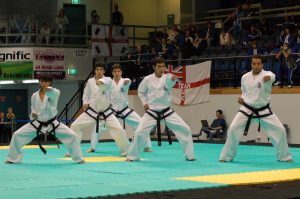
Team
- Designated pattern draw will take place whilst both teams are on the floor.
From the second round of the draw a coin will be tossed to decide which team goes first. The winning coach of the toss decides which team performs as first. - The first team will perform 2 patterns and the second team will do likewise.
- The winning team will progress to the next round.
Team Patterns additional Guidelines
The team may line up in any format they choose and team members may perform movements individually, or together, as they choose, but it must be seen to be teamwork.
For example: one team member may not perform moves of the Pattern on his own without the other team members following in unison
Scoring Method:
Patterns are Judged according to the following criteria:
Technical Content (5 points)
Power (5 points)
Rhythm (5 points)
- Team Patterns are also Judged on Teamwork (5 points)
TECHNICAL CONTENT (5 POINTS)
Technical Content refers to:
- Correct pattern diagram, all steps performed
- Appropriate start and finish positions
- Appropriate posture and facing
- Techniques performed at correct height and direction of travel
- Proper tool used for blocking, striking or kicking
- Correct Stance dimensions and weight distributions
- Correct use of sine wave
- Correct stepping, pivoting and turning
- Maintaining equilibrium whilst stepping, turning and pivoting
- Remaining stable whilst kicking, including slow movements
- Control of body weight and momentum
- Kihaps performed in appropriate places
- incorrect ready stance (-1)
- break in pattern sequence but continue within 3 secs (-2)
- (-1 for Technical Content and -1 for Rhythm(see below))
- absence of Kihups in patterns (-1)
- if a movement is performed incorrectly, either once or throughout pattern (-1)
- incorrect Name of Pattern called at completion of pattern (-1)
- 3 wrong movements performed in the pattern (0 points)
- stop pattern completely without resuming within 3 secs (0)
- wrong pattern performed (0)
- missing technique in pattern (0) points
RHYTHM (5 POINTS)
Rhythm refers to:
- Timing of the pattern movements in accordance with encyclopaedia recommendations
- Absence of delayed pauses, or irregular sequences
- Pattern completed from start to finish in one continuous sequence
- Performing the pattern too fast (-1)
- Irregular sequences or pauses (-1)
- break in pattern sequence but continue within 3 secs (-2) (-1 for Rhythm and -1 for Technical Content(see above)
POWER (5 POINTS)
Power refers to:
- Correct application of sine wave
- Use of reaction arm
- Appropriate utilization of larger muscle groups, and transfer of body weight
- Acceleration of movements
- The appropriate use of breath for each movement
- Correct strength and timing of breath
- lack of power (-1)
- lack of reaction force (-1)
- no acceleration of movement (-1)
- uncontrolled stop power (-1)
All patterns are judged according to the recommendations of the Founder of Taekwon-Do, General Choi Hong Hi, along with updates made by the International Taekwondo Federation.
Central Umpire (Patterns)
Responsibilities
- Control the procedure of the bout
- Ensure competitors abide by the competition rules
- Allocated penalties where appropriate
- Communicate with Jury President
- Clearly signal all decisions to judges.
Patterns – Umpire Terminology
CHARYOT – ATTENTION
KYONG YE – BOW
JUNBI – READY
SIJAK – BEGIN
BARO – RETURN
JU UI – WARNING
HONG – RED
CHONG – BLUE
DONG CHON – TIE
SUNG – WINNER
PATTERNS JUDGES
Responsibilities:
- To score the bout according to official scoring criteria
- To have a thorough knowledge of technique / patterns
- To record and tally scores precisely
- To be consistent and non-biased in scoring
During the bout:
- the Corner Referee must be up to date with all the I.T.F. Tournament Rules
- sit properly and must observe with attention the competitors’ actions
Jury President
Responsibilities
Oversee the procedure of the bout
- Ensure competitors abide by the competition rules
- Communicate with Tournament Organizing Committee
- Monitor performance of judges and referees – provide feedback
- Scrutinize score sheets and then announce results to Centre Umpire
- Consult with the Tournament director in regards any appeals
DISQUALIFICATION
- misconduct against officials or ignoring instructions
- any behaviour deemed to be unsporting, offensive, or not in the spirit of fair competition
- any competitor suspected of being under influence of alcoholic beverages or drugs
Active Participants in this course will be issued a C-Class ITF Umpire Certificate.
This level is issued by the National Organization.
Importantly, regardless of your certified level, you must possess the skills and confidence to effectively control and officiate ITF competitive matches in all events
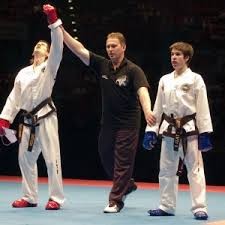
written by Master Michael Muleta, 8th Degree
ITF Umpire Committee Member 2002-2014
Awarded ‘Outstanding Umpire, 2007 ITF World Championships‘
President & Technical Director, United ITF Taekwon-Do Australia
